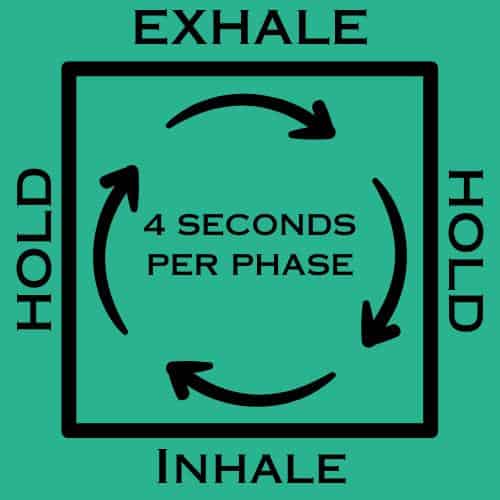Table of Contents
When you’re dealing with anything as extreme as an active shooter situation, or something normal like stress at work, Box Breathing is your best friend.
When SHTF it's vital you keep yourself calm and composed at all times. Operators are trained to utilize techniques such as box breathing to maintain alertness and composure while making mission critical decisions. In high-stress situations, it is important to stay focused on the immediate threat or issue. Civilians can benefit from adopting these practices in their personal and professional lives as well.
This technique is used by Navy SEAL’s, other special operations forces, law enforcement as well as professional athletes and everyday people who need to manage their stress.
This tactical breathing technique can help you remain calm and focused in high-pressure situations.
By controlling your breathing pattern, you can easily control your adrenaline levels (which will be spiking to all time highs) and reclaim your clarity and focus in any situation.
This technique can be used anywhere and at anytime to get you back in the game, in just one minute of meditative breathing.
What is Box Breathing?
Box Breathing is a loop breathing pattern, it’s a series of repeated actions lasting in total for 4 seconds each that you repeat for at least one minute.
It takes time to notice the changes after just a minute, so start practicing it as part of daily stress relief.
Most people believe it was developed by Lieutenant Colonel David Grossman who served as a US Army Ranger, however it’s real roots trace back to the yogic breathing practice of pranayama, the specific technique is called sama vritti pranayama.
It’s adaption in today’s world is mostly due to the fact that it’s used by the world’s most elite special operations units during high-stress missions.
It’s also known as square breathing or 4×4 breathing.
How to start Box Breathing
Exhale through your mouth for 4 seconds.
Do not breathe for 4 seconds.
Inhale for 4 seconds through your nose.
Hold the breathe in for 4 Seconds.
Repeat

Starting to get where the name box breathing comes from?
It’s important that you take the time to breathe deeply and let the breaths flow easily in and out of your body.
During a firefight or other intense stressful scenario it won’t be easy to give yourself the chance to do this and if you’re not already experienced in situations like these, your first instinct is going to be to panic.
This is why it’s vital to practice and implement box breathing into your everyday life.
Utilizing it while at work, school or with friends and family, it becomes your second nature response to stressful conditions, which in turn makes it the first thing you will turn to during a life threatening situation when SHTF.
Why use the Box Breathing Technique?
There are multiple ways to approach stress reduction, and among them, slow breathing techniques have proven to be effective in the long term.

However, high-stress situations require an immediate and rapid response to calm your body and mind, going into shock or freezing up the wrong moments can mean loss of situational awareness and death in some situations.
Adrenaline
Adrenaline is an intense chemical that is released in our body when we are faced with a stressful, sometimes fight or flight situation.
Adrenaline can negatively impact our ability to be in control during stressful situations.
It can make our hearts race, our hands shake and our thoughts and responses erratic making it difficult to focus and respond effectively.
This can cause us to make impulsive decisions, act rashly or even panic.
The surge of adrenaline can also hinder our ability to think clearly, which can make it difficult to analyze a situation and make informed decisions.
It can also have some positive effects such as providing an energy boost if going into fight mode and when experienced and calm under pressure, can even enhance perception and focus, but this takes experience and training to master.
The Nervous System
Box breathing has significant calming effects on your autonomic nervous system, which regulates different functions in your body.
This system has two parts, the sympathetic and the parasympathetic. The former stimulates the fight or flight response, while the latter is responsible for resting.
Holding your breath, as done while box breathing, increases the amount of CO2 in your blood, which slows down the heart rate and activates the parasympathetic nervous system, leading to a feeling of relaxation.
In other words, box breathing is a simple yet powerful way to reduce stress and increase calmness in high-stress situations.
Heart Rate
When you engage in box breathing you are holding your breath half of the time.
This triggers a physiological response in your body, you temporarily increases the amount of carbon dioxide (CO2) in your bloodstream.
This increase in CO2 levels has been linked to several effects, one of which involves the lowering of heart rate. Essentially the buildup of CO2 in your blood activates a cardioinhibitory response, which can regulate your heartbeat and slow it down.
This response is thought to be a protective mechanism, as slowing down your heart rate allows your body to conserve oxygen.

Box breathing is a powerful technique to calm the mind and focus on the immediate threat. However, it can take some time to get used to and learn to master for use in life or death situations.
So it’s important to take things slow, begin by starting to implement it whenever you feel yourself getting stressed or overwhelmed with your day to day life.
Eventually you will be able to handle anything life throws at you like an experienced operator and the likelihood of any situation being able to fully overwhelm you becomes extremely low.


